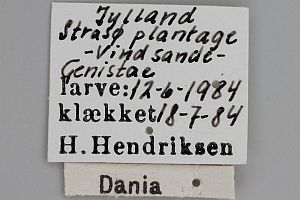

 +20Kontinente:EU
+20Kontinente:EU3. Biologie
3.1. Nahrung der Raupe
- [Fabaceae:] Genista pilosa (Behaarter Ginster)
Buhl et al. (1984: 1) berichten: "The larva of Syncopacma suecicella (Wolff) has been found for the first time. As far as we know it has not been deseribed previously. !t is reddish brown with a light grey pattern consisting of a clear dorsal line, two lateral lines and indistinct mottles between the lines. The head is black with brown shadows in the middle. The prothoracic plate is black, divided in the middle and rounded posteriorly. The legs and the anal plate are also black. The trunk segments are set with many small warts, each with a relatively long white hair." S. 10 ist dann zu erfahren: "Syncopacma suecicella (Wolff). W J: Vind, antal la. 12.vi.l983, Genista pilosa (P. Falck, K. Larsen), Kronhede Plantage (Klosterhede), i antal 3. viii.l983 (K. Gregersen) og Ulfborg, i antal 9.-l2.viii.l983 (0. Karsholt, K. Schnack). Larven, der os bekendt ikke tidligere er beskrevet, spinder skudspidserne af foderplanten Genista pilosa sammen. Der er ofte mange larver på samme plante."
Nach den Ausführungen von Gregersen & Karsholt (2022: 86) scheint Heckford (1986) durch diese Arbeit angeregt worden zu sein, auch in Großbritannien an dieser Pflanze nach der Art zu suchen - erfolgreich.
(Autor: Erwin Rennwald)
4. Weitere Informationen
4.1. Andere Kombinationen
- Stomopteryx suecicella Wolff, 1958 [Originalkombination]
- Syncopacma suecicella (Wolff, 1958) [bis Aarvik et al. (2017) übliche Kombination]
4.2. Taxonomie
Aarvik et al. (2017: 163) teilen mit: "We consider Aproaerema anthyllidella (Hübner, 1813), type species of the genus Aproaerema Durrant, 1897, as subordinate within the genus Syncopacma, 1925. Aproaerema has priority. This change of name is prompted because Landry & Roque-Albelo (2010) suggested that Untomia Busck, 1906 is a further senior synonym of Syncopacma. Wir müssen also jetzt alle 27 bisherigen Syncopacma-Arten in die Gattung Aproaerema stellen.
4.3. Faunistik
Nach SwissLepTeam (2010) ist die Art auch Faunenbestandteil der Schweiz (Jura).
Šumpich (2013: 25) meldete die Art als neu für Kroatien: "Pakoštane near Biograd, 15.–17.vii.2003, 19 ♂; Pirovac env., Tisno, 23.viii.2004, 2 ♂, 13.–20.viii.2007, 3 ♂; Pelješac penin., Žuljana, 1.–13.vii.2005, 1 ♂. Known from western, northern and central Europe, in the Balkans recorded in Greece. First record for Croatia."
4.4. Typenmaterial
Wolff (1958: 270): “Holotype: labelled Bonarpshed 21. 7. 53. P. Benander leg. incl. genital slide NLW 1730 presented to the coll. Zool. Mus. Copenh. Paratypes in the coll. of the author.”
4.5. Literatur
- Aarvik, L., Bengtsson, B.Å., Elven, H., Ivinskis, P., Jürivete, U., Karsholt, O., Mutanen, M. & N. Savenkov (2017): Nordic-Baltic Checklist of Lepidoptera. — Norwegian Journal of Entomology - Supplement No. 3: 1-236. [PDF auf entomologi.no]
- Buhl, O., Karsholt, O., Larsen, K. Palm, E. & K. Schnack (1984): Fund af småsommerfugle fra Danmark i 1983 (Lepidoptera). — Entomologiske Meddelelser, 52: 1-21.
- Gregersen, K. & O. Karsholt (2022): The Gelechiidae of North-West Europe. — 939 pp., Oslo, Norway (Norwegian Entomological Society).
- Heckford, R.J. (1986): Syncopacma suecicella (Wolff) (Lepidoptera: Gelechiidae) new to the British Isles. — Entomologist's Gazette, 37 (2): 87-89. [Sekundärzitat]
- Šumpich, J. (2013): Faunistic records of some Microlepidoptera from Croatia. — Entomologia Croatica, 17 (1–4): 13–33. [PDF auf hrcak.srce.hr] bzw. [PDF auf entomologicalservice.com]
- SwissLepTeam (2010). Die Schmetterlinge (Lepidoptera) der Schweiz: Eine kommentierte, systematisch-faunistische Liste. — Fauna Helvetica 25. Neuchâtel (CSCF & SEG).
- Erstbeschreibung: Wolff, N. L. (1958): Further Notes on the Stomopteryx Group (Lepid. Gelechiidae). — Entomologiske Meddelelser 28: 224-281, pl. 3-4. [PDF auf danbif.dk]
























